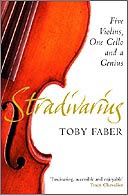
Stradivarius
by Toby Faber
(Pan, £7.99)
Amazingly, books touching on Stradivarius - or, more properly, Antonio Stradivari - are rarer than the violins he made. Apart from John Meade Falkner's ghost story, The Lost Stradivarius, this appears to be the only one in print. I am not at all sure how this can be so. Everyone has heard the name, and even the scantest knowledge carries with it the dim sense that the instruments he made are not only special, but seem to have a soul of their own; that they are in some sense alive, so intimate is the connection between player and the sound she or he can get out of one; and that Stradivari had a secret way of making violins which has never been duplicated or explained.
Yo-Yo Ma, the cello virtuoso who inherited Jacqueline du Pré's Stradivarius, said it took him two months' playing to get a decent sound from the instrument; but after that "the sound kept on coming and coming". They are also fantastically expensive, to the degree that we are entering the region of sums of money which are almost mystical; in fact, it is odd to think of the fact that Strads can be bought and sold at all. But they are; the names they are given are usually those of previous owners.
The most famous of them all, though, the "Messiah", got its name after one prospective purchaser said, in exasperation, that the violin he was waiting for was like the Messiah, because you wait and wait for it and yet it never showed up. The Messiah did show up in the end; and now it hangs in the Ashmolean in Oxford. It is the template for almost all copies that have ever been made of a Strad; it was immensely influential even in the design of modern violins. It is also in virtually mint condition, for it has hardly ever been played. I am not sure, even after reading this book, whether there is anyone alive today who knows what it sounds like. This book traces the fortunes of, as its subtitle puts it, "five violins, one cello, and a genius".
Stradivari did not, as you will have worked out by now, only make violins. You could have 11 performing string quartets all using Strads; but he never really got the hang of violas, so it's best not to get too hung up on that particular idea. There is plenty else here to get hung up on: with all the heady mixture of extreme genius, vast amounts of money, not to mention sheer cultural fascination, there is material here for at least half a dozen ideas for films.
The 1999 film, The Red Violin, proposed that the (fictional) Cremonese luthier Niccolo Bussotti used his dying wife's blood to give his varnish that extra kick, but Faber does not stoop even to mention such melodramatic theories. Nor does he make too much of the diabolical associations of the violin, and the rumours of Tartini's and Paganini's dealings with Old Nick. He has enough to be getting on with: Luigi Tarisio, the slovenly but unrivalled expert, dying in poverty in a Milanese tenement, two violins clasped to his body, with others scattered about the room. When another dealer, who on hearing the news had raced to the next of kin as fast as he could, asked anxiously about the whereabouts of the violins, he was told: "We haven't touched the dirty junk yet."
There is Du Pré, unable to feel the strings beneath her fingers, or Viktoria Mullova, the Soviet defector who left her government-owned Strad on her hotel bed; the KGB wasted valuable hours not looking for her; no one, they reasoned, would leave a Strad behind. Imagine that parting.
There is more, much more; the side of professional string-playing that is mostly hidden from us (you wouldn't believe what players do to revive their instruments after a dehydrating transatlantic flight), as well as the strange confluence of art, connoisseurship and money which is how the violin-dealing world operates. As to the secret of a Strad's sound, you will be relieved to discover that even when analysing the wood and varnish at virtually molecular level, no one is yet completely sure how he did it.

